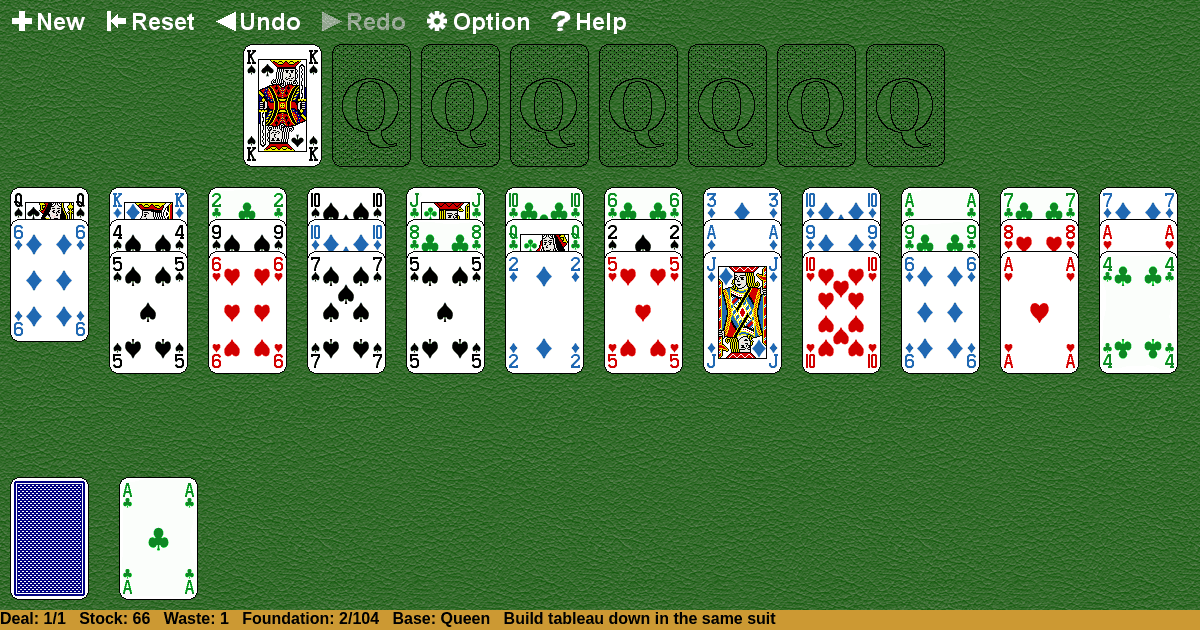Quadrangle
Home |
How to play |
FAQ |
About
How to play Quadrangle?
Game Objective:
The primary goal in Quadrangle Solitaire is to move all 104 cards (using two standard 52-card decks) to the eight foundation piles, building each foundation up in suit from a designated base rank until each contains a complete sequence of thirteen cards.
Setup & Layout:
- Deck: Two standard 52-card decks (total 104 cards).
- Foundations: Eight piles. The first foundation pile is started with a single face-up card drawn from the deck; this card determines the base rank for all foundations. The remaining seven foundations are started with cards of the same rank as soon as they become available.
- Tableau: Twelve piles, each dealt three cards face-up in a splayed (overlapping) manner.
- Stock: The remaining cards form the stock pile, placed face-down.
- Waste: One pile, initially empty, used to hold cards dealt from the stock.
Key Play Areas:
- Foundations: Where cards are built up in suit, starting from the base rank.
- Tableau: Main play area where cards are built down in suit.
- Stock: Supplies additional cards, dealt one at a time to the waste.
- Waste: Holds cards from the stock; only the top card is available for play.
Quadrangle Solitaire Rules:
Card Movement Principles:
- Only the top card of each tableau pile or the waste pile may be moved at any time.
- Sequences cannot be moved; only single cards are moved at a time.
Building on Foundations:
- Foundations are built up in suit, starting from the base rank (e.g., if the base is 7, build 7-8-9-…-K-A-2-3-4-5-6).
- Continuous (wrap-around) building is allowed: after King comes Ace, and after Ace comes 2, continuing up to one rank below the base card.
- Only cards of the same suit and the next rank in sequence may be played onto a foundation.
- Empty foundation spaces can only be filled with a card of the base rank.
Building on Tableau:
- Tableau piles are built down in suit (e.g., 10♠ on J♠, 9♠ on 10♠).
- Continuous (wrap-around) building is allowed: after Ace comes King, and after King comes Ace, when building down.
- Only the top card of each tableau pile is available for play.
- Only one card may be moved at a time; sequences cannot be moved.
Stock and Waste:
- The stock deals one card at a time face-up to the waste pile when activated.
- No redeals: the stock can only be passed through once.
- The top card of the waste pile is always available for play to the tableau or foundations.
Gameplay:
- Initial Moves:
- Examine the tableau and foundations for available moves.
- Move cards from tableau or waste to foundations if possible, following suit and sequence rules.
- Move cards between tableau piles, building down in suit.
- Dealing from Stock:
- When no further moves are possible or desired, deal one card from the stock to the waste pile.
- Use the top card of the waste for further moves to the tableau or foundations.
- Filling Empty Tableau Spaces:
- When a tableau pile becomes empty, it is immediately filled with the top card from the waste.
- If the waste is empty, fill the space with the top card from the stock.
- If both stock and waste are empty, any card may be moved to fill the empty tableau space.
- Play Continues:
- Continue moving cards and dealing from the stock until all cards are moved to the foundations or no further moves are possible.
Winning & Losing Conditions:
- Winning: The game is won when all 104 cards are successfully moved to the eight foundations, each built up in suit from the base rank through a complete sequence of thirteen cards.
- Losing: The game is lost (or becomes unwinnable) if no further legal moves are possible and not all cards have been moved to the foundations. Since there are no redeals, if the stock and waste are exhausted and no moves remain, the game ends unsuccessfully.
Special Rules & Edge Cases:
- Filling Empty Foundations: Only a card of the initial base rank may fill an empty foundation space.
- Filling Empty Tableaus:
- Automatically filled with the top card from the waste.
- If the waste is empty, filled from the stock.
- If both are empty, any card may be moved to the empty tableau.
- Continuous Building: Both foundations and tableau allow wrap-around building (King to Ace and Ace to King), maintaining suit continuity.
- No Sequence Moves: Only single cards may be moved at a time; partial or complete sequences cannot be transferred.
- No Redeals: The stock can only be used once; after it is exhausted, no further cards can be dealt.
- Immovable Foundations: Once a card is placed on a foundation, it cannot be moved back to the tableau or waste.
Note: Quadrangle Solitaire is considered a challenging game with a low win rate, requiring both skillful planning and luck.

Solitaire Collection
About Quadrangle
Rate (Quadrangle)
4.7 / 5
1,916 votes



























































